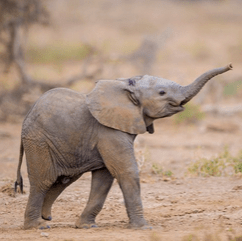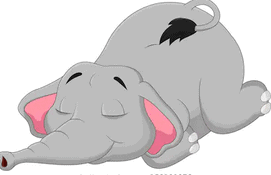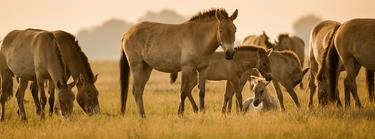A Day With Nandu Class 4 Worksheet EVS Chapter 3
Q1: Fill in the Blanks
(i) Nandu is an _____.
Ans: Nandu is an elephant.
An elephant is a large mammal known for its distinctive trunk and tusks, which is the species that Nandu belongs to.

(ii) Elephants like to play in _____ and _____.
Ans: Elephants like to play in mud and water.
Elephants enjoy playing in mud and water as it helps to cool their bodies, protect their skin, and is also a form of social interaction.
(iii) _____ is the oldest in this herd of elephants.
Ans: Nani ma is the oldest in this herd of elephants.
Nani ma refers to the matriarch of the herd, who typically has the most experience and knowledge about the group.
(iv) The ____________ is an extension of the upper lip and nose, serving various functions such as grasping, breathing, feeding, and lifting.
Ans: The Elephant's trunk is an extension of the upper lip and nose, serving various functions such as grasping, breathing, feeding, and lifting.
The trunk of an elephant is a versatile tool that allows them to interact with their environment in numerous ways.
(v) A group of elephants is commonly called a ____________, typically led by one female elephant.
Ans: A group of elephants is commonly called a Herd, typically led by one female elephant.
In elephant social structure, a herd is usually made up of related females and their young, with a matriarch leading the group.
Q2: Multiple Choice Questions
(i) Who is the leader of the elephant herd?
(a) Oldest male
(b) Oldest female
(c) Young female
(d) Young male
Ans: (b)
In many elephant herds, the oldest and most experienced female, often referred to as the matriarch, assumes the leadership role. She guides the herd in finding food, water, and shelter, as well as making decisions during times of danger or conflict.
(ii) What are the external teeth of the elephant called?
(a) Tusk
(b) Molar
(c) Pre Molars
(d) All
Ans: (a)
The tusks of an elephant are elongated, specialized incisors that grow from the upper jaw. They are used for digging, lifting objects, and sometimes for defense or display.
(iii) Male elephants live in the herd till the age of:-
(a) 10 years
(b) 15 years
(c) 12 years
(d) 20 years
Ans: (b)
Male elephants usually stay with their natal herd until they reach adolescence, which is typically around the age of 12 to 15 years. After this age, they may leave to lead more solitary lives or form bachelor groups.
(iv) What is the approximate weight of adult elephant?
(a) 200kg
(b) 400kg
(c) 300 kg
(d) 500 kg
Ans: (d)
The weight of an adult elephant varies greatly depending on the species. However, none of the options provided accurately reflects the weight of an adult elephant. Adult elephants can weigh anywhere from around 2,700 kg (5,950 pounds) for a smaller Asian elephant female to over 6,000 kg (13,200 pounds) for a larger African elephant male.
(v) What is the Sun's role in sustaining life on Earth?
(a) Provides a platform for life
(b) Controls the weather
(c) Major source of energy for life on Earth
(d) Illuminates the night sky
Ans: (c)
The Sun is the primary source of energy for life on Earth through photosynthesis, providing essential light and heat that sustain plants and the entire food chain.
Q3: True and False
(i) When Nandu woke up, he was in a grey forest.
Ans: False
The statement is false; Nandu was not in a grey forest when he woke up.
(ii) Nandu is the oldest elephant in the herd.
Ans: False.
Nandu is actually the youngest elephant in the herd.
(iii) Elephant Trunks are only used for breathing and feeding.
Ans: False
Elephant trunks serve multiple functions, including grasping, dusting, smelling, drinking, and lifting heavy objects.
(iv) Male elephants actively participate in raising their young within a herd.
Ans: False
Male elephants generally do not play a significant role in raising their young.
(v) The Sun is the largest star in the Solar Family.
Ans: False
The Sun is a medium-sized star and is not the largest star in the solar system.
Q4: Short Question Answer
(i) What does the baby elephants like doing the most in the jungle?
Ans: Baby elephants like to play in the water in the jungle.
(ii) What is the function of big ears of the elephant?
Ans: The big ears of an elephant function much like a fan. By flapping their large ears, elephants can effectively keep themselves cool.
(iii) Why did Amma gently pushed Nandu towards the water?
Ans: Amma gently pushed Nandu towards the water because she wanted him to play in the water.
(iv) Who are the members of an elephant herd?
Ans: 10 - 12 Female elephants and baby elephants (both male and female) are the members of an elephant herd.
(v) When does the male member of the herd leave the herd?
Ans: When the male member becomes 13-14 years old, he leaves the herd.
(vi) Why do animals move in herds?
Ans: Animals move in herds in search of food.
(vii) How much of leaves can an elephant eat in one day?
Ans: In one day an elephant can eat more than 100 kgs of leaves and twigs.
(viii) What does the member of herd do after reaching to the jungle?
Ans: After reaching the jungle, the members of the herd spread out to eat their favourite leaves and twigs. Subsequently, they move to the river to play in the water. The mother elephants lie down in the water and mud along the riverbank.
(ix) For how long does the elephant sleep in a day?
Ans: The elephant sleep for 2 to 4 hours a day.

(x) What is the age and weight of Nandu?
Ans: Nandu was three months old and he weighs 200 kg.
(xi) What happened when Nandu reached close to water?
Ans: When Nandu reached close to the water a strong fountain of water fell on his head and he sot wet.
(xii) Who is the leader of an elephant herd?
Ans: The oldest female elephant in the herd is the leader of an elephant herd.
(xiii) What are animal herds?
Ans: When animals live in groups, it is called animal herds.
 (xiv) Apart from elephants, name other animals that live in forests?
(xiv) Apart from elephants, name other animals that live in forests?
Ans: Apart from elephants, the other animals that are found in the forest are lions, tigers, monkeys, snakes, deer etc.
(xv) Apart from elephants, name the animals that live in herds.
Ans: Apart from elephants, the animals that live in herds are ants, lions, wolf, penguins etc.
|
52 videos|352 docs|54 tests
|
FAQs on A Day With Nandu Class 4 Worksheet EVS Chapter 3
| 1. How can I prepare for the Class 4 exam on "A Day With Nandu"? |  |
| 2. Can you provide a summary of the article "A Day With Nandu"? |  |
| 3. What are the main themes explored in "A Day With Nandu"? |  |
| 4. How does "A Day With Nandu" relate to real-life experiences? |  |
| 5. What lessons can be learned from "A Day With Nandu"? |  |

















